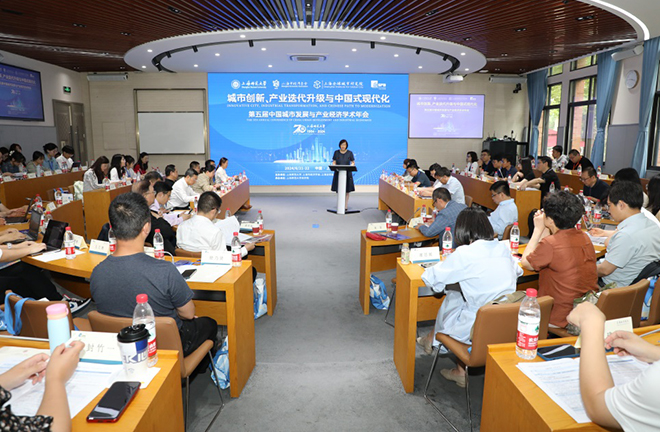Urban innovation drives Chinese modernization

The Fifth Annual Conference of China Urban Development and Industrial Economics in Shanghai Photo: Zha Jianguo/CSST
SHANGHAI—In today’s world, cities have become central hubs of modern industrial economies and technological innovation. To further explore new pathways for urban development and upgrading in China, the Fifth Annual Conference of China Urban Development and Industrial Economics, themed “Innovative City, Industrial Transformation, and Chinese Path to Modernization,” was held in Shanghai on June 22.
New developments
“With the deepening of globalization, urban development models and theories need to be updated. The connectivity and complexity of global cities also necessitate new research methods and theoretical support,” said Zhou Zhenhua, president of Shanghai Institute for Global City (SIGC). Traditional urban economic theory falls short in explaining the spatial dynamics of global cities. The unique connectivity of global cities extends beyond geographical boundaries and is more reflected in the interconnection of networks. Zhou advocates for China’s global city research to move beyond the limitations of traditional theories, strengthen urban internal and external connectivity, and leverage the interaction between cities to facilitate the flow of China’s economic, cultural, and informational factors and accelerate the development of domestic and international “dual circulation,” playing a leading and exemplary role in the high-quality development of China’s economy.
The security and resilience of global supply chains have become a key focus for many countries. According to Jiang Chuanhai, secretary of the Party committee of East China University of Science and Technology, the current global trend is characterized by complex changes that pose severe challenges to China while also offering opportunities for the industrial transformation of its cities. China has achieved milestone progress in consolidating industrial scales, upgrading industrial structures, and improving industrial quality. However, it still faces issues such as a weak industrial foundation, limited industrial specialization, and low industrial governance power.
In the current landscape of shifting global division of labor, economic interactions and trade relations among countries are undergoing profound adjustments. Zhang Jun, dean of the School of Economics at Fudan University, stressed the significance of rebalancing China’s economic development. He suggested that China needs to further expedite its direct investment overseas, create a more favorable domestic market environment, and expand the size of the domestic market by opening up the service sector and other means. Meanwhile, it is also necessary to shift more government transfer payments towards households and transition the tax system from an enterprise production-dominated mode to one oriented towards household consumption as early as possible.
New quality productive forces
As global competition in the manufacturing industry intensifies, rapidly enhancing productivity and competitiveness has become a critical concern for all countries. Participating scholars agreed that new quality productive forces have injected fresh impetus into sustainable development.
Yin Desheng, dean of the School of Economics and Management at East China Normal University, pointed out that China’s new quality productive forces are primarily concentrated in the fields of integrated circuits, electronic communications, computer equipment manufacturing, and biomedicine, with significant regional disparities in their development. At present, key areas for their growth include digital transformation, industrial chain modernization, and cutting-edge technology research and development. This necessitates more efforts to upgrade the traditional industrial chain, cultivate future industries and strategic emerging industries, and drive innovation through the digital economy.
“As the three major engines of economic development, the recovery of consumption, investment, and exports have garnered wide attention,” said Zhong Ninghua, deputy dean of the School of Economics and Management at Tongji University. In terms of consumption, China’s total consumption has gradually recovered, buoyed by rapidly developing tourism. Regarding investment, there is an urgent need to accelerate the shift towards urban renewal, industrial upgrading, and the green economy. In terms of exports, China is expanding into emerging markets and increasing foreign direct investment. Chinese enterprises are rapidly growing into multinational corporations, and Chinese manufacturing is forging new drivers and competitive advantages in international markets.
In the view of Liu Jianghui, dean of the School of Finance and Business at Shanghai Normal University (SHNU), the global urban network is characterized by volatility, communities, and multi-polarization. In this context, researchers of urban studies need to address shifts in global division of labor theories and the resulting changes in policy and practice. China’s megacities, aiming to develop into international metropolises deeply linked to the globe, not only need to have strong internal circulation support, but must strike a balance between internal and external circulation. They are tasked with playing a leading role in the global city network, coordinating high-quality “inbound” and high-level “outbound” strategies, and materializing the vision of urban innovation and industrial upgrading “in China, for the world.”
The conference was co-sponsored by SHNU, the Shanghai Economic Association, and the SIGC.
Edited by YANG LANLAN

 PRINT
PRINT CLOSE
CLOSE